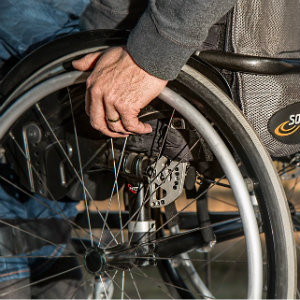Has your child been diagnosed with spastic quadriplegic cerebral palsy? Your family may be asking such questions as:
- What caused this condition?
- Did a healthcare professional make a mistake during childbirth?
- Should we consider a malpractice claim?
During this difficult time, the experienced birth injury lawyers at Monheit are committed to helping your family.

We're prepared to hold negligent medical professionals liable for malpractice and secure the compensation your family needs following a serious birth injury.
Spastic quadriplegia is the most severe form of cerebral palsy. Those who suffer from this condition have trouble controlling movement in their arms or legs, and many are unable to walk. Like other forms of cerebral palsy, it is caused by brain damage or abnormal brain development, usually prior to birth.
Spastic cerebral palsy is also the most common type of CP - roughly 80% of people with CP are spastic. Spastic is a classification for increased muscle tone, which causes stiffness and difficulty moving. Quadriplegia means that the entire body is affected - including the trunk, face, arms, and legs.
Is Medical Malpractice To Blame?
If your child has recently been diagnosed as a spastic quadriplegic, you may be looking for answers. How much could have been done to prevent this condition?
While some cases of spastic quadriplegia may be unavoidable, others are caused by medical malpractice. In these cases, healthcare professionals usually failed to notice and address warning signs, such as:
- Infections
- Changes in fetal heart rate
- Situations which require a c-section
- Prolapsed umbilical cords
Improper use of delivery tools can also cause head trauma leading to spastic quadriplegia.
If you suspect that one or more of these negligent actions contributed to your child's condition, you have rights. An experienced birth injury attorney can help you to hold negligent medical professionals liable for the many expenses your family is facing.
FREE CONSULTATION
Symptoms
Symptoms of spastic quadriplegia are usually first noticed when certain developmental milestones are delayed. There are a few defining characteristics of spastic quadriplegic cerebral palsy:
- Stiff and scissoring limbs - Stiff limbs which involuntary cross are an early warning sign. If your child still has stiff and scissoring limbs after two months, we recommend consulting a doctor.
- Inability to crawl or stand after 12 months - Healthy children should have developed the ability to stand and crawl by the time they reach one year of age. A lack of this ability is often a warning sign of impaired motor skills.
- Contractures - Joints which cannot stretch or move, even when a parent or doctor attempts to do so.
- Clonus - A series of involuntary muscle contractions alternating with relaxations.
- Dystonia - Continuous or repetitive muscle contractions which cause twisting, repetitive movements, or fixed postures.
Many children with SQ also have intellectual disabilities, suffer from seizures, and have vision, hearing, or speech impairments. If you notice any of these warning signs in your child, you should contact a doctor immediately.
Causes
We've already established that spastic quadriplegia is caused by brain damage. The National Institutes of Health (NIH) list four types of brain damage which could cause this condition in developing fetuses:
White Matter Damage
The brain's white matter is in charge of transmitting signals throughout the body. This region of the brain is particularly vulnerable between weeks 26 and 34 of development. If damaged, movement throughout the entire body could be disrupted. Holes and lesions in this area of the brain frequently cause spastic quadriplegia.
Abnormal Brain Development
Disruptions in brain development may lead to breakdowns in brain signal transmissions. This often causes permanent damage to the nervous system. Examples of fetal brain complications include:
- Genetic mutations
- Infections
- Fevers
- Physical trauma
Expectant mothers should undergo regular doctor's visits in order to catch possible warning signs of abnormal brain development as soon as possible.
Bleeding Inside Brain
Internal brain bleeding occurs when blood vessels are broken or become blocked. Fetal stroke is often the cause of this problem. Common causes for fetal stroke include:
- Blood clotting in placenta
- Weak blood vessels in brain
- Maternal high blood pressure
- Maternal infections
Reliable physicians will regularly monitor expectant mothers for these problems and address them promptly. Catching warning signs early is the best way to prevent serious complications like spastic quadriplegia.
Oxygen Deprivation
Prolonged oxygen deprivation in the brain often leads to permanent brain damage. Brief lapses in oxygenation are common in the womb, but anything more than five minutes can have irreversible consequences. This commonly leads to a type of brain damage called hypoxic-ischemic encephalopathy. This condition destroys brain tissue and permanently impairs motor skills and other functions.
Treatment
SQ requires a variety of long-term medical treatments. While there is no cure for cerebral palsy, symptoms can be managed. Each case of SQ is unique, and different people will require different combinations of treatment.
Physical Therapy
Physical therapy can help manage mobility issues by strengthening muscle groups and improving function. Balance, coordination, and flexibility can all be improved through regular physical therapy.
Occupational Therapy
Occupational therapists help develop basic movement skills that are relevant to daily routines. The goal is to help patients develop the skills necessary to function at home, school, and work.
Specifically, occupational therapists focus on improving strength, fine motor skills, and coordination. They also help to develop cognitive abilities like problem-solving, decision-making, and memory.
Speech Therapy
Many patients struggle with communication. A speech therapist can help develop language and communication skills, as well as oral bodily functions like swallowing and digestion.
Medication
Patients may be prescribed muscle relaxers to help reduce the uncontrollable movements associated with spastic quadriplegia. Other medications can manage muscle stiffness. Patients who suffer from epilepsy will require medication to manage seizures.
Surgery
In some cases, surgery can improve joint problems, shortened muscles, and hearing, vision, and speech impairments.
Info For Families
Monheit Law Montgomery County Office 215-866-2018
Directions to our Montgomery County Injury Law Office
4V4Q+FM Jenkintown, Pennsylvania
Open 24 hours
Spastic quadriplegia attorney Jenkintown
Civil law attorney
Employment attorney
Law firm
Attorney
Social security attorney
Monheit Law South Philly Office 215-302-0095
Directions to our South Philly Injury Law Office
WRCH+CP Philadelphia, Pennsylvania
Open 24 hours
Spastic quadriplegia attorney South Philly
Civil law attorney
Employment attorney
Law firm
Attorney
Social security attorney
